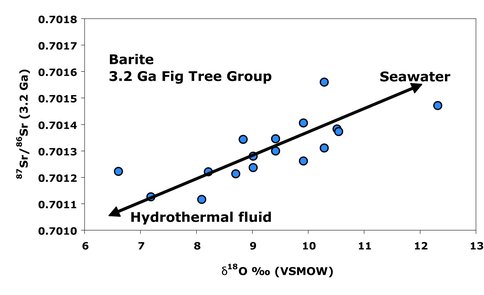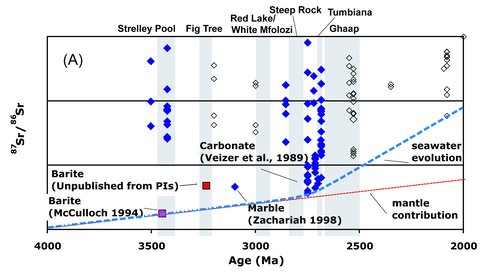2014 Annual Science Report
 University of Wisconsin
Reporting | SEP 2013 – DEC 2014
University of Wisconsin
Reporting | SEP 2013 – DEC 2014
Project 3C: The Role of Early Continental Weathering in Providing a Habitable Planet
Project Summary
Recent studies of biogeochemical cycles recorded in Archean sedimentary rocks suggest an early diverse microbial ecology that may have required extensive continentally-sourced nutrients (i.e., phosphorus) early in Earth history. Widespread continental weathering is at odds, however, with studies that suggest a majority of continental crust was submerged and seawater chemistry was largely controlled by oceanic hydrothermal fluids. Here, we present new Sr and O isotope results from stratiform barite deposits from the 3.23 Ga Fig Tree Group, South Africa. The Sr and O isotope data indicate the barite was formed from a mixture of hydrothermal fluids and seawater, and that seawater was more radiogenic then previously predicted. The only appreciable source of radiogenic Sr is from continental weathering, and thus we propose that continental weathering was more extensive throughout the Archean than previously thought. This in turn has important implications for the availability of continentally-sourced nutrients to early marine environments on Earth.
Project Progress
Bjerrum and Canfield (2002) first suggested a “phosphorus crisis” during the Archean in which they suggested phosphorus (a limiting nutrient for microorganisms) would have been highly depleted from seawater due to its high absorption affinity to iron oxides. Konhauser et al. (2007) refuted this idea by suggesting that high Si concentrations in Archean seawater would have limited to ability of phosphorus to absorb to iron oxides, and thus a “phosphorus crisis” was unlikely. These debates notwithstanding, it is recognized that continental weathering is the most likely source for phosphorus in seawater. Traditional assessments of continental weathering have been done using Sr isotope compositions of marine carbonate (e.g., Shields and Veizer 2002); however, Archean carbonate is rare and in many instances altered to the point where the primary ocean signal has been lost. The low solubility and high Sr contents (>2000 ppm) of marine barite makes them perfect targets to assess the Sr isotope composition of the fluids from which they precipitated. There are little reliable data from carbonate at this time, thus the barite from the 3.23 Ga Fig Tree Group are crucial for testing the possible influences that continental weathering may have had on ocean chemistry. Strontium and oxygen isotope results are shown in Figure 1. The positive trend suggests that barite formed as a mixture of hydrothermal fluid and seawater, thus at a minimum, seawater must have had a Sr isotope composition of ~0.7015, much higher than previously reported (~0.7007) by Shields and Veizer (2002).
In Figure 2, we plot our new results for 3.2 Ga barite with other Sr isotope data. Also plotted are data from McCulloch (1994) for hydrothermal barite of 3.4 Ga age, which McCulloch noted likely reflected a mantle value and hence a lower limit to the seawater Sr isotope composition. Our new results suggest that the assumed alignment of the seawater and mantle Sr isotope curve in the Archean (Figure 2) is likely incorrect, and requires a significantly greater continental input via continental weathering. This conclusion is counter to the arguments that the continents were submerged throughout most of the Archean (Flament et al., 2013). This is an important result because it implies that microbial organisms may not have been nutrient limited, supporting the discoveries that a diverse microbial ecology existed during the Archean.
References Cited
Bjerrum CJ, Canfield DE (2002) Ocean productivity before about 1.9 Gyr limited by phosphorus adsorption onto iron oxides. Nature. 417: 159-162.
Flament N, Coltice N, Rey PF (2013) The evolution of the 87Sr/86Sr of marine carbonate does not constrain continental growth. Precambrian Research. 229: 177-188.
Konhauser KO, Lalonde SV, Amskold L, Holland HD (2007) Was There Really an Archean
Phosphate Crisis? Science. 315: 1234.
Shields G, Veizer J (2002) Precambrian marine carbonate isotope database: Version 1.1. Geochemistry, Geophysics, Geosystems. 3: 1-12.
-
PROJECT INVESTIGATORS:
-
PROJECT MEMBERS:
Clark Johnson
Project Investigator
Brian Beard
Co-Investigator
Max Coleman
Collaborator
Donald Lowe
Collaborator
Aaron Satkoski
Collaborator
-
RELATED OBJECTIVES:
Objective 1.1
Formation and evolution of habitable planets.
Objective 4.1
Earth's early biosphere.
Objective 6.1
Effects of environmental changes on microbial ecosystems
Objective 7.1
Biosignatures to be sought in Solar System materials
Objective 7.2
Biosignatures to be sought in nearby planetary systems

